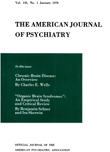Anticholinergic activity of two tricyclic antidepressants
Abstract
Using a double-blind crossover Latin square design, the authors evaluated the peripheral anticholinergic and central nervous system effects of three dose levels of two tricyclic antidepressants in female volunteers. Results showed that 5 hours after drug administration, desipramine (50 and 100 mg) caused significantly less reduction in salivation than did amitriptyline. Amitriptyline produced more sedation (Clyde Mood Scale) and a greater number of subjective complaints than did desipramine. These results are consistent with anticholinergic profiles from animal experiments and suggest that clinically meaningful differences may exist among tricyclic antidepressants.
Access content
To read the fulltext, please use one of the options below to sign in or purchase access.- Personal login
- Institutional Login
- Sign in via OpenAthens
- Register for access
-
Please login/register if you wish to pair your device and check access availability.
Not a subscriber?
PsychiatryOnline subscription options offer access to the DSM-5 library, books, journals, CME, and patient resources. This all-in-one virtual library provides psychiatrists and mental health professionals with key resources for diagnosis, treatment, research, and professional development.
Need more help? PsychiatryOnline Customer Service may be reached by emailing [email protected] or by calling 800-368-5777 (in the U.S.) or 703-907-7322 (outside the U.S.).



